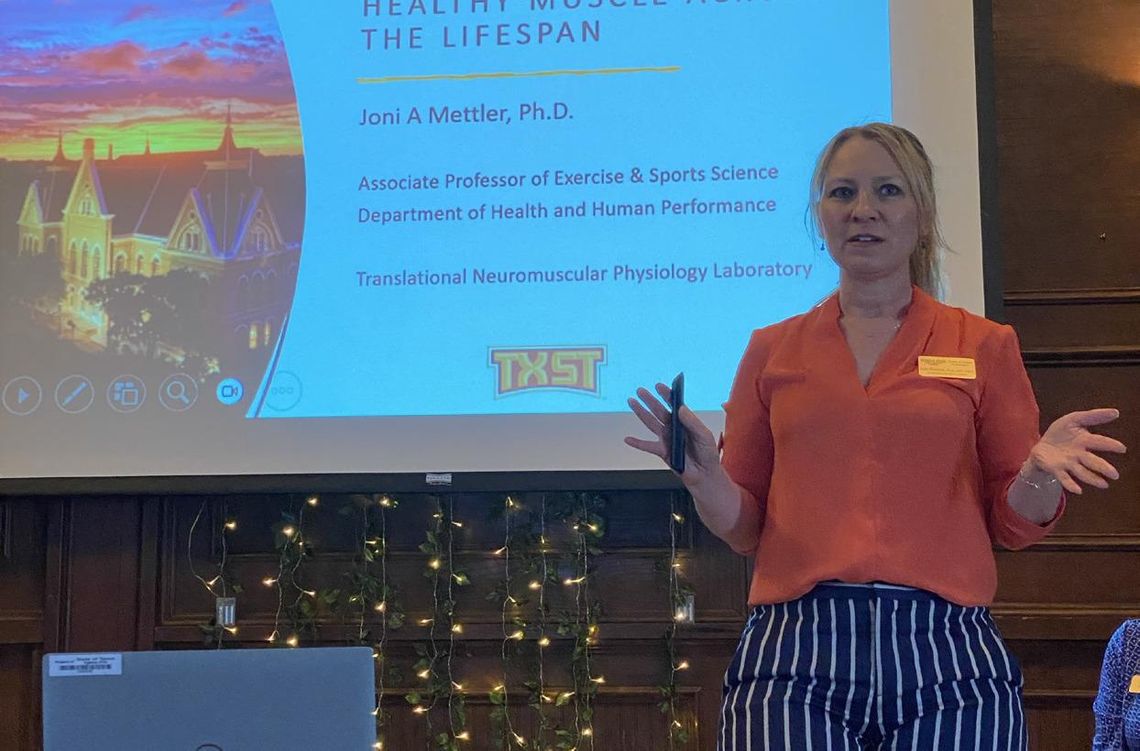University educators give class to help with aging
Some of the body's basic functions decline with age, but much can be done to combat these growing inefficiencies. A panel of collegiate experts came to the Price Center to talk about the research they’ve done in several vastly different areas—interior design, light, balance, exercise and muscle mass decline—and tricks to assist the aging body in a graceful—and hopefully a less achy—decline.
Dr. Denise Gobert, professor of physical therapy at Texas State University presented tips on how to maintain balance as we age.
“Good balance improves your general mobility, so you’ll move more and your muscles and bones will get stronger,” Gobert said. When your balance deteriorates, you stop moving. You’re scared.”
She said an important exercise to increase balance is to stand on one leg for a period of time and then the other—with a chair for safety—because it emphasizes one side of your body to maintain the strength and balance of that side.
“The more symmetrical you are, the better you are to shift from one side to the other side to dynamically walk [and] move in space,” Gobert said. “If you don’t use it, you lose it.” She added that not practicing balance on both sides will lead to becoming asymmetrical, which puts a person at higher risk to lose balance in one direction.
Gobert dispensed a handout with specific exercises to regain balance. One involves holding a chair in front of you and standing with feet together and eyes closed for 60 seconds. Then, with eyes still closed, lift one leg for 30 seconds then switch and do the same with the other. She said if you cannot do 30 seconds, work your way up.
Dr. Joni Mettler, associate professor of physical therapy at Texas State University, discussed the decline of muscle mass with age and the positive impacts of exercise and diet on the aging body. She said it’s important to maintain healthy muscle across the lifespan to facilitate movement.
Sarcopenia is “the loss of muscle strength, the loss of muscle mass and the loss of physical function that occurs throughout the aging process,” Mettler said, adding that in 2017 Sarcopenia was made a diagnosable medical condition.
Mettler said dietary protein and resistance training can have a huge impact on muscle decline. She said that it is important to have at least 30 grams of lean, high quality protein per meal, which equates to a piece of meat approximately the size of a deck of cards.
“There’s no difference between the older adults and the younger adults in a fasting state in terms of their ability to have protein synthesis or muscle building processes,” Mettler said. “Just by eating about 30 grams of lean beef, we have a 50% increase in our protein synthesis response.” She added that, with the intake of 30 grams of protein, there was still no difference between the younger and older group in their ability to build muscle, but with only 15 grams of protein the decline was much higher for older adults.
She said, in a study she recently completed, the older, non-resistance trained group performed the worst in a series of exercises. She said the resistance trained older group and the younger not resistance trained group performed the same in power exercises. She said the young resistance trained and the old resistance trained group were the same in sit-to-stand exercise performance, and the young resistance trained and old resistance trained group walked the same distance in six minutes.
Dr. Asha Hegde, professor of interior design at Texas State University, focused on lighting color and intensity and how it impacts health and behavior. She said that, as we age, we need more light and more appropriate light color and intensity. She said, as the years go by, the pupil gets smaller, the lens gets thicker and opaque and less light is entering the pupil to signal the photoreceptor. So, she said glare free, higher light intensity is beneficial for vision in older age.
“They’re all white light, but they are made up of different wavelengths— different color,” Hegde said. “Here the spectrum is just as important as the time of day … [the] quantity of light, intensity of light, the color of light and the timing of day is very important for us.”
Hegde said for morning and afternoon cool colored light with high intensity is better, and for the evening warm light with lower intensity. She added that at night, there should be no light because it damages the circadian rhythm. She said that, if a nightlight is needed for safety, a warm shade should be put on it.
“Mimicking what is happening in the natural cycle [with sunlight] is really going to impact our sleep, our mood, our productivity [and] our attention,” Hedge said. “When people are in sync and in rhythm with that day, night cycle, their sleep has improved by 46 minutes.”
Dr. Nadim Adi, assistant professor of interior design at Texas State University, discussed the ways in which dementia can be positively impacted by the design of a space. One of the studies he conducted was about hospital design.
“When a person who is advanced in age … gets an injury,” Adi said. “The first place you think to go to is the hospital, and unfortunately, the research shows that, in a hospital … they usually pick up another injury or an infection.” Adi added that for those with dementia the chances double.
Adi said that normally when designing a hospital, an interior designer would focus on the ability of doctors and nurses to move about the space, and usually the focus for the patient is having a place to sleep and the capacity to fit the bed and wheelchair through the door. Through his research, he found that it was helpful for those with dementia to decrease clutter and shadows in the hallways.
“For someone with dementia that kind of corridor [full of clutter and shadows] might as well be barricaded,” Adi said. “They’re going to take the long way around, and that increases their chances of falling.”
If you’re interested in participating in a free research study, Gobert is currently working on research to retrain gait and balance after a stroke and is looking for participants. Eligible candidates will have had a stroke more than six months ago with weakness on one side of the body and unable to stand for five minutes, but able to walk ten meters. To participate in the study, reach out to Dr. Hao-Yung Hsiao at hhsiao@austin. utexas.edu or Gobert at [email protected].




